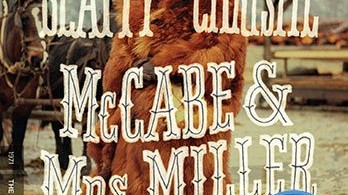In conjunction with The Criterion Collection’s latest release, the Aero Theater hosted a double bill screening of Robert Altman’s McCabe & Mrs. Miller (1971) and a documentary about its cinematographer No Subtitles Necessary: Laszlo and Vilmos (2009). Screening these two entries together in a crowded theater of cinephiles (including members of the Altman family) was an excellent way to express the spirit and mission of The Criterion Collection as one of the few companies focused on preserving film for future generations. McCabe & Mrs. Miller is the most recent addition to the Criterion catalog, and here is some insight as to why the 1971 film is worth a revisit today.
Warren Beatty and Julie Christie play the titular McCabe & Mrs. Miller, respectively. In an early 1900s frontier mining village in the Pacific Northwest, McCabe, a flawed businessman, attempts to build a brothel to make money off of the nearly all men town (ironically named Presbyterian Church). He crosses paths with the British prostitute Mrs. Miller, who quickly intervenes and says that if he’s starting a whore house then she is to be his partner. McCabe, much to his chagrin, is persuaded into agreeing. The unlikely partners develop their ambitious goals as a frontier village slowly builds around them, with a colorful cast of miners, outlaws, prostitutes, and other townspeople all brave enough to endure this harsh American landscape.
Amongst the auteur-loving crowd, Robert Altman stands shoulder to shoulder with Coppola or Scorsese. One of his signatures is his masterful use of ensemble casts, and McCabe is surprisingly another incredible display of this talent. Sure, Gosford Park (2001), Short Cuts (1993), and Nashville (1975) boast more star-studded ensembles, but in this film, every single member of the small frontier town are utilized and developed. There are no ‘extras’ here: the townspeople are funny, endearing, and given storylines that play out in full. In the film’s climax, the nuanced development of the entire ensemble pays off as Altman stages a sequence that employs the entire town in a thrilling, unforgettable conclusion to the movie.
It’s worth emphasizing the importance of this new restoration as a way of keeping this film in the utmost quality it was meant to be viewed as. One of the treats of this double feature was after seeing the restoration, I saw clips of the pre-restoration version in the documentary, which was released in 2009. The difference is stunning: shots beforehand are muted and darker shades blend together, whereas in the restoration everything pops and the intentionality of DP Vilmos Zsigmond is on display.
Seeing the movie in theaters instead of on the Criterion disc meant I won’t be able to review any of the supplemental material, but the screening introduction by documentarian James Chressanthis included memorable anecdotes and insights into the film’s creation. On the note of cinematography, Altman and DP Zsigmond were both fed up with the oversaturated Technicolor look of Hollywood that was at the time the norm, so instead opted for a muddy, grainy look to establish the rough frontier town and the grit that came with it. When the studio received the dailies, they were horrified at the results. Altman reassured them that the Vancouver lab where the temp prints were being made (the film was shot in British Columbia) was not up-to-par and that the negatives would be just fine. He was, of course, fooling them and continued to shoot in this style so by the time they were done the studio had no choice but to release the film as such. This rebellious photography is still gorgeous in its own right and more importantly utilizes the visuals to convey the story at hand, always a mark of a master DP.
Between the aforementioned photography, beautifully matched songs by Leonard Cohen, and two memorable performances from the leads, this film holds up as an essential example of American cinema at a time when the film industry was reaching a cultural explosion. For classic movie aficionados and casual moviegoers alike, there is much to be savored from the Criterion’s latest entry.
H. Nelson Tracey
Nelson is a film director and editor from Denver based in Los Angeles. In addition to writing for Cinemacy, he has worked on multiple high profile documentaries and curates the YouTube channel "Hint of Film." You can check out more of his work at his website, hnelsontracey.com


